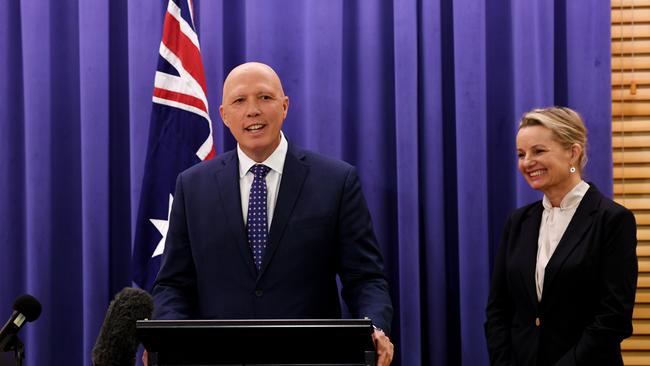To win over women, Liberals need to open up the boys club
If the Coalition doesn’t see the sense in embracing quotas to fix the gender gap after its election wipeout, it never will.

The success of the teal independents saw six women win seats off five blokes and one unlucky woman. Celia Hammond losing her seat of Curtin has deprived the Liberal Party of arguably its most credentialed woman in parliament. Hammond was a university vice-chancellor before leaving academe for what turned out to be a short-lived career in politics.
Six quality women now have entered the parliament in traditionally safe Liberal seats, but they won’t sit with the Coalition.
While both Coalition parties have rustled up a pair of women to serve as deputies to the blokes, the number of women in the ranks of the depleted opposition is thin – certainly compared with Labor, which courtesy of its quota system has near-equal representation.
This has been a slow and steady build for Labor, to the point where it also now has 10 women in the 23-strong cabinet, a record, and 13 in the overall ministry.
Labor has managed such representational growth despite losing Kristina Keneally and Terri Butler at the election, both shadow cabinet ministers.
We will wait for electoral studies to confirm what polls have already told us: the gender divide in voting was catastrophic for the Liberal Party. Women delivered this election to Anthony Albanese, both in the way they deserted the government in key marginal seats and the price paid fighting a war on two fronts against the teals.

To be sure, the coming term will be a difficult one for Labor. The economy is on the brink and challenges abound. It also has to contend with its own third-party challenge: the surging of the Greens. But the biggest take-out from election 2022 was that women rose up to punish the Liberal Party.
Sussan Ley’s elevation as the Liberals’ deputy leader will be interesting if for no other reason than she has advocated for quotas within the party. She said this week she’d raise the issue at the next party room meeting. She’ll have to do better than that. Only nine of the 58 Liberals in the house are women. Raising the idea in a room full of men who have dedicated what intellectual thought they possess to finding excuses not to embrace quotas – almost solely because Labor did it first – will be like shouting in the forest.
I recall interviewing Barnaby Joyce years ago and catching him off guard when he was in full flight explaining why quotas were degrading and tokenistic, interrupting him to ask why then was it OK for the Nationals to have a quota for the number of frontbench positions it got in the Coalition agreement. To Joyce’s credit, his pause for thought and his response – “I’ll get back to you on that, I hadn’t thought about it like that” – at least were honest.
Since then, the callow arguments against quotas have come thick and fast: the Coalition quotas are subject to party arrangement and therefore different. The practicalities of implementing gender quotas are harder for the Coalition parties because they don’t have a rigid factional system like Labor. And my favourite: women don’t want quotas.
While I have advocated gender quotas for the Liberal Party for more than 1½ decades, the speed and need for change requires even more radical action. Liberals need to implement some form of positive discrimination to get high-calibre women into their ranks who already are fit to serve on the frontbench. Women with CVs to match the teal independents, for example; perhaps even to take them on.
Because the disguise act we see in the Liberal Party – putting a disproportionate number of women on its frontbench to mask the fact the parliamentary ranks are so thin – can’t continue. The party needs a critical mass on the backbench it can choose from, and the only way to make that happen quickly is to find a way to convince qualified women to run for parliament for the conservatives.
It is a two-step process: fix the policy scripts conservatives adhere to that many women don’t like; and find a formula to get more women to run for parliament. Ley could do a lot worse than devote herself to this process between now and the next election. Having nailed her colours to the quota-mast when serving penance on the backbench between ministries, it is important she doesn’t go weak at the knees now that she is in a position to help effect change. She has been around long enough to witness first-hand how blokey the Coalition is. Ley became an assistant minister during the final term of John Howard’s government, before serving on the opposition frontbench, then in the ministry of all three prime ministers during the past 8½ years. Peta Credlin was a huge wrap for Ley, strongly advocating for her promotion to cabinet when Tony Abbott was prime minister. But Ley is just one woman in a depleted party room.
To effect change, the blokes have to get on board. The only senior male Liberal I can think of to passionately advocate quotas is NSW Treasurer Matt Kean. Scott Morrison privately pledged to look seriously at them before being re-elected in 2019, as Wayne Errington and I revealed in our book about the former prime minister – ironic, really, given the problems with women Morrison’s government had thereafter. Perhaps he should have listened to his own advice.
Hammond isn’t the only woman in Liberal ranks to lose her seat. Katie Allen lost Higgins, Fiona Martin was defeated in Reid, Lucy Wicks was edged out in Robertson, and Amanda Stoker looks unlikely to return to the Senate. The parliamentary ranks of the Liberal Party are actually worse now when it comes to gender representation than they were previously.
While Peter Dutton cops a lot of flak for his standing as one of the hard men of the right, and I can’t really see him flipping on the issue of quotas, he is at least alive to the need to do something. But what that something is has been elusive for too long if it isn’t going to be quotas.
Paul Keating once said: “In the race of life always back self-interest, at least you know it’s trying.” It is in Dutton’s self-interest to fix the Liberal Party’s (perceived and real) woman problem – because if it doesn’t, he’ll never become prime minister.
Peter van Onselen is a professor of politics and public policy at the University of Western Australia and Griffith University.




If the Liberal and National parties now aren’t prepared to stare into the reality that they have a gender problem, they never will.